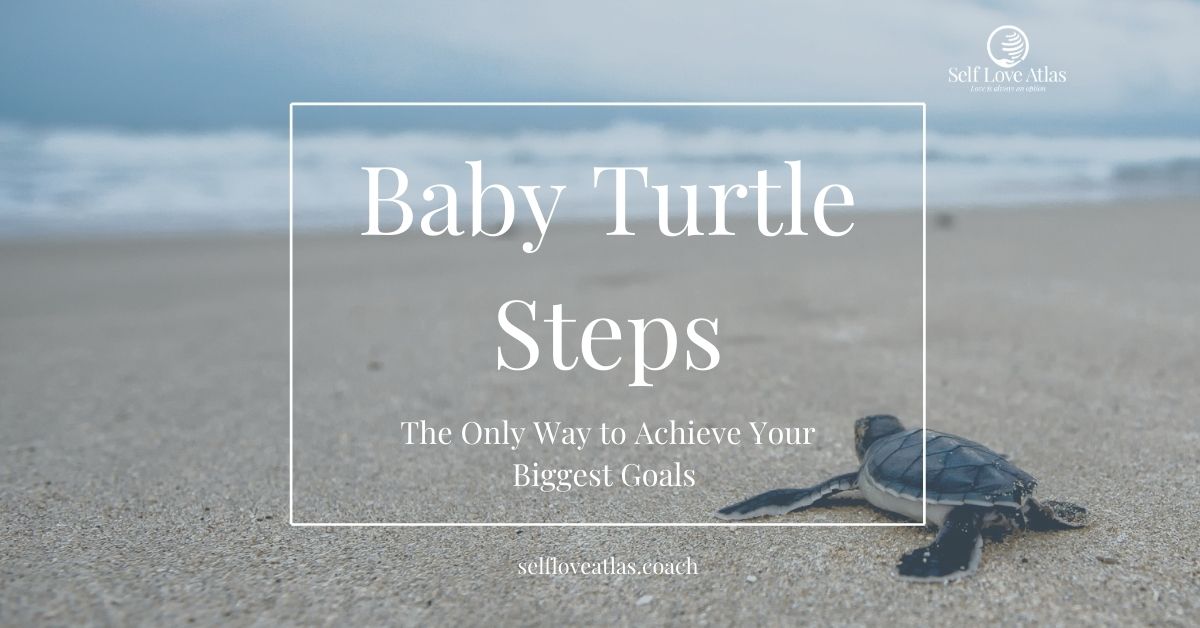Baby Turtle Steps: The Only Way to Achieve Your Biggest Goals
As I’ve begun practicing coaching over the last few months, I’ve found that many of you have some big and beautiful goals. Whether you’re aiming to pay for your current schooling, start a nonprofit, transform your relationships, or build your own career, your big goals are milestones towards a more fulfilling life. And while I’m so genuinely excited for all of you, I also know that striving to reach these big milestones isn’t easy.
In the process of chasing and achieving your goals, we both know you’re going to hit some road blocks. You likely already have. Whether it involves unexpected inconveniences, personal failures, or the fear of judgement from others, there will be moments where your big goals don’t feel possible.
This is normal.
It’s a natural part of striving for something big that you’ve never done before.
But when something feels impossible, it doesn’t mean it’s actually impossible. So you need to be careful not to interpret sources of discouragement as a sign that you should give up.
Every time you try despite that feeling of impossibility, you directly expand what is possible for you and your life.
Even if you had thousands of days where you didn’t try, or thousands of days where you were backsliding, every little step you take will grant you more progress and personal growth than the vast majority of people who used their discouragement as a reason to give up entirely.
So in this post, I want to talk about a simple way to divide your big goals into little steps, steps you can take one after the other, even when times are tough, so you can feel confident in your ability to achieve your biggest goals.
For the sake of this post, we’ll be referring to these little steps as “baby turtle steps” to emphasize that bits of progress that are both small and slow are still extremely worthwhile and valuable. In my mind, taking these kinds of steps is the only way anyone achieves big goals. Without them, nobody would get hardly anywhere.
The Biggest Mistake We Make When Striving to Achieve Our Biggest Goals
Dreaming of achieving our goals can be either a pleasurable or a discouraging experience. It all depends on how you mentally frame it.
If, when thinking about your goals, you imagine being in the place of future achievement, and allow yourself to imagine the pleasure (or perhaps pride) that comes from having arrived at the end of your goal, you bring those positive feelings of your ideal future into the present. This can help get you excited and motivate you to do what it takes to get there.
In other words, your excitement has the potential to propel you forward. (Disclaimer: dreaming without doing will not propel you forward, but it is absolutely possible to use your own emotions to get you moving.)
But when we start to get discouraged, we tend to move away from the pleasure of our imagination. Instead, we start repeating a broken record of fears in our minds. We think, “This probably won’t happen because I never…” or “I always….”. We focus on the potential problems like, “Other people will think…” or “Something is going to ruin…” or “Nobody will…”.
These fears distract us from our goals and make them seem far more complicated and intimidating than they really are. When we focus on those fears, we get swallowed up in the foggy water of our own discouragement. We drown in it. And we feel tempted to succumb and call it the end, but it’s not.
If we could just wade in that foggy water long enough to keep our heads above water and wipe our eyes, we could see clearly that the path toward our biggest goals is beautifully simple.
The Path Forward
It’s far too easy to look at the big picture of our goal and get overwhelmed with the sheer size of it. Just the thought “I have no idea how I’m going to make that happen” is enough to deter some people from trying at all.
But when we really think about it, the “how” part is a lot simpler than our minds make it out to be. Ultimately, how we achieve our biggest goals will be the same “how” that everyone has used to achieve big things.
That “how” is simply small steps, or as I like to call them, baby turtle steps. Baby turtle steps are bits of progress that are tiny, but still necessary parts of our journey towards our success. (I call them baby turtle steps because baby steps are small, and turtle steps are slow…although a lot of turtles are scarily faster than you’d expect.)
Imagine you’re a baby turtle trying to get to the ocean. You’re at your starting point, and you have a ways to go. The distance to your goal is far bigger than you are. But the only way you’re ever going to get there is if you start moving. So no matter how small your little legs feel, every step you take takes you closer to freedom.

It’s really important that we allow ourselves to be okay with small and slow forms of progress.
If we don’t, then we might use the lack of milestone or Instagrammable/Facebookable moments as evidence that we’re not progressing fast enough. This is a painful thought, and because every person’s path is unique, it isn’t true.
As my first life coaching professor always said, you cannot be behind in your own life. Your life is uniquely yours, and it’s not supposed to be anything other than what it is, or whatever you make it into.
If you want something different, then it’s worth taking the steps to get there, no matter where you are now, or how long it took to get here thus far. But there’s no benefit to telling yourself you’re not where you’re supposed to be right now.
“The only way out is through”
-Robert Frost
How to Decide on Your Own Baby Turtle Steps
While the path to your destination may not be as clear as a turtle’s beeline to the ocean, designing your own path paved with baby turtle steps is incredibly simple. All you need to do is ask yourself the same question over and over again until you break down your big goal into tiny, manageable, bite-sized pieces.
- Just start with your big goal and ask, “What do I need to do to make this happen?”
- Write yourself a list, and if the tasks you wrote down feel big and intimidating, then hold one of them in your mind and ask again, “What do I need to do to make this happen?”
- Do the same with all the other list items until all the pieces feel manageable to you.
If you continue asking this question with all the pieces of your goal, you’ll eventually have a long list of tiny do-able steps you can take to make your big goal happen.
This is crazy simple, but also crazy helpful, because if you know that your tiny steps have the potential to add up to your ultimate goal, then you don’t need to get stressed out about the big picture. You can just trust that if you do the small things, then the big thing will literally inch closer to you until you just have it.
Of course, there will still be setbacks and challenges. There’s no way to avoid that. But I strongly believe that if we can just reduce the stress we experience when we think about our goals, we give ourselves a much better shot at actually doing it.
“You don’t have to get it perfect, you just have to get it going. Babies don’t walk the first time they try, but eventually they get it right.”
-Jack Canfield
In Conclusion,
If we can be okay with slow progress, and progress in small doses, then we are setting ourselves up for not only success, but resilience, patience, endurance, and strength.
So if you’re looking at a big goal and feeling paralyzed by its size and complexity, just know that it can be simpler than it seems if you just ask the right question.
After that, it’ll just be one step after another until one day, that thing you’ve been striving for will suddenly be much closer than you thought.
Did this post resonate with you? If so, I’d love to hear from you! Leave a comment or send me a message to share your thoughts. For more uplifting content, check out some other posts on my blog, follow me on instagram @morgan_barbret, or sign up for the Self Love Atlas Newsletter!
Cheers,
Morgan Rita Barbret





